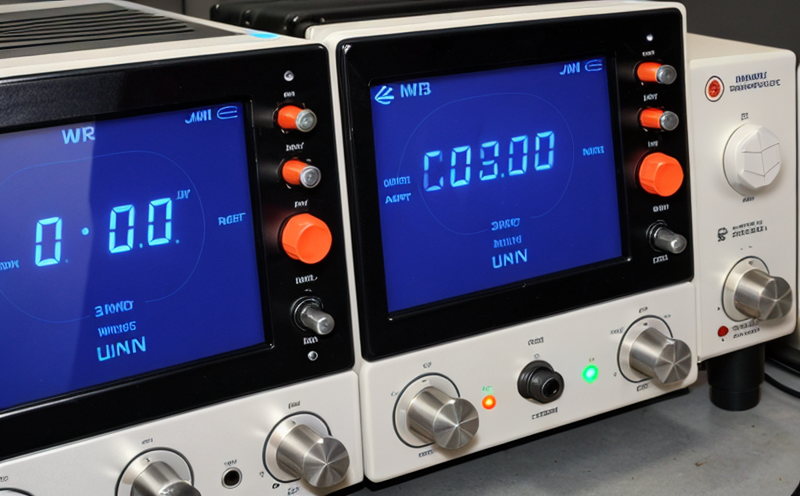ANSI C63.4 RF Emission Testing of Wireless IoT Devices
The ANSI C63.4 standard is a critical tool in ensuring that wireless Internet of Things (IoT) devices meet the necessary emission limits set forth for consumer and industrial use. This testing ensures that these devices do not interfere with other electronic systems, including radios, televisions, and medical equipment.
The ANSI C63.4 standard defines a method for measuring RF emissions from wireless IoT devices to ensure compliance with FCC Part 15 regulations in the United States. Compliance with this standard is essential for manufacturers and developers of such devices to avoid potential penalties and ensure consumer safety.
Testing involves exposing the device under test (DUT) to a frequency range that includes all bands within which it operates, typically from 30 kHz to 1 GHz, though sometimes extending up to 6 GHz. The DUT is placed in an anechoic chamber or a reverberation chamber where its emissions are measured and compared against the limits specified by ANSI C63.4.
Preparation of the device for testing includes ensuring that all components, including any external antennas if applicable, are correctly connected and configured to replicate real-world usage scenarios as closely as possible. This ensures accurate measurement results which can then be used to determine compliance with regulatory requirements.
The test setup includes a spectrum analyzer or a network analyzer capable of measuring emissions across the relevant frequency range. The DUT is placed in such a way that it simulates real-world conditions, including any environmental factors like distance from other devices and obstacles present within a typical home or office environment.
Once testing has been completed, detailed reports are generated showing the measured RF emissions against the specified limits outlined by ANSI C63.4. These reports provide valuable insights into both compliance status as well as any potential areas for improvement in terms of reducing interference with other devices operating within the same frequency bands.
Compliance with ANSI C63.4 is not only crucial from a regulatory standpoint but also beneficial for businesses looking to build trust with consumers who are increasingly concerned about electromagnetic radiation exposure. By ensuring their products meet these stringent standards, companies can position themselves as leaders in responsible technology development and production.
It’s important to note that while ANSI C63.4 focuses on consumer devices like smart speakers, thermostats, and home security systems, many industrial IoT applications also need similar testing to ensure they do not cause interference or receive unwanted interference during operation.
Applied Standards
- FCC Part 15: The Federal Communications Commission's rules governing the emission limits for various types of electronic equipment, including IoT devices.
- IEC 62301: International Electrotechnical Commission standard which covers emissions and immunity requirements for information technology equipment.
The ANSI C63.4 standard itself is part of a broader suite of standards designed to ensure that electronic devices operate safely without causing harmful interference to other devices. It aligns closely with international standards like IEC 62301, providing manufacturers and regulators with consistent guidelines for assessing emissions.
By adhering to these standards, businesses can demonstrate their commitment to creating safe products while also preparing themselves for potential future regulatory changes or market demands that may require even stricter limits on RF emissions.
Industry Applications
- Consumer Electronics: Smartwatches, fitness bands, and other wearables must comply with ANSI C63.4 to ensure they do not cause interference in public spaces.
- Smart Home Devices: Such as smart lights, thermostats, and doorbells need to be tested for compliance to prevent potential disruptions within the home environment.
- Medical Devices: Portable medical devices like patient monitors or emergency pagers should undergo rigorous ANSI C63.4 testing to ensure they function correctly without causing interference in hospitals or other healthcare settings.
In addition to these specific sectors, any IoT device intended for public use will benefit from ANSI C63.4 compliance as it helps protect against unintended consequences such as dropped calls or disrupted communication services caused by excessive RF emissions from nearby devices.
Why Choose This Test
- Regulatory Compliance: Ensuring that your product meets the stringent requirements set out in ANSI C63.4 helps avoid potential fines and penalties from regulatory bodies.
- Consumer Trust: Demonstrating compliance with this standard builds confidence among consumers regarding the safety of their products.
- Market Advantage: Being able to market your product as compliant with ANSI C63.4 gives you a competitive edge over non-compliant competitors.
Incorporating ANSI C63.4 into your quality assurance process shows that you take the safety and functionality of your devices seriously, which is increasingly important in an era where consumers are more aware than ever before about electromagnetic radiation exposure.





